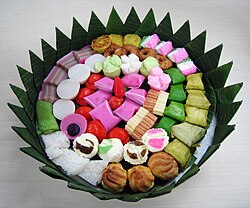

|
Added details.
Tags: Visual edit Mobile edit Mobile web edit Advanced mobile edit
|
mNo edit summary
Tags: Visual edit Mobile edit Mobile web edit Advanced mobile edit
|
||
| Line 7: | Line 7: | ||
There are different types of snacks sold in the traditional markets in Java: ''jajan pasar'', ''kue'', ''bolu'', and ''roti''. ''Jajan pasar'' refers to native Javanese snacks; ''kue (''from Chinese ''gao; kwe)'' refers to some western cakes and steamed cakes of [[Chinese language|Chinese]] origin; ''bolu'' (from [[Portuguese language|Portuguese]] ''bolo'') refers to sponge cakes and some other types of cake with a similar texture; while ''roti'' (from [[Sanskrit]] ''rotika'') refers to any baked goods in general.<ref name=":0" /><ref>{{Cite web|last=Kuaranita|first=Fellycia Novka|date=2021-02-11|title=Asal-usul Kue Keranjang, Sajian Khas Tahun Baru Imlek|url=https://klasika.kompas.id/baca/asal-usul-kue-keranjang-sajian-khas-tahun-baru-imlek/|access-date=2021-03-11|website=Klasika|language=en-US}}</ref><ref>{{Cite web|last=Media|first=Kompas Cyber|date=2019-10-27|title=Menelusuri Sejarah Bolu dalam Tampilan Oleh-oleh Tanah Pasundan|url=https://lifestyle.kompas.com/read/2019/10/27/121338820/menelusuri-sejarah-bolu-dalam-tampilan-oleh-oleh-tanah-pasundan|access-date=2021-03-11|website=KOMPAS.com|language=id}}</ref> |
There are different types of snacks sold in the traditional markets in Java: ''jajan pasar'', ''kue'', ''bolu'', and ''roti''. ''Jajan pasar'' refers to native Javanese snacks; ''kue (''from Chinese ''gao; kwe)'' refers to some western cakes and steamed cakes of [[Chinese language|Chinese]] origin; ''bolu'' (from [[Portuguese language|Portuguese]] ''bolo'') refers to sponge cakes and some other types of cake with a similar texture; while ''roti'' (from [[Sanskrit]] ''rotika'') refers to any baked goods in general.<ref name=":0" /><ref>{{Cite web|last=Kuaranita|first=Fellycia Novka|date=2021-02-11|title=Asal-usul Kue Keranjang, Sajian Khas Tahun Baru Imlek|url=https://klasika.kompas.id/baca/asal-usul-kue-keranjang-sajian-khas-tahun-baru-imlek/|access-date=2021-03-11|website=Klasika|language=en-US}}</ref><ref>{{Cite web|last=Media|first=Kompas Cyber|date=2019-10-27|title=Menelusuri Sejarah Bolu dalam Tampilan Oleh-oleh Tanah Pasundan|url=https://lifestyle.kompas.com/read/2019/10/27/121338820/menelusuri-sejarah-bolu-dalam-tampilan-oleh-oleh-tanah-pasundan|access-date=2021-03-11|website=KOMPAS.com|language=id}}</ref> |
||
However, in urban areas, the word "kue" is used to refer to all kinds of food products mentioned above.<ref name=":1">{{Cite web|last=Ridha|first=Author Muhsin|date=2019-01-28|title=Cara Membuat Kue basah yang Enak dan Bikin Nagih|url=https://usaharumahan.id/cara-membuat-kue-basah/|access-date=2021-03-11|website=Usaha Rumahan|language=en-US}}</ref> This happened due to a strong influence of Chinese descents' language use in the areas. More than 90% or Chinese descents in Indonesia (who may not speak fluent Chinese, but would incorporate some Chinese words into their speech) lives in the cities, where Indonesian language is spoken as a ''lingua franca.'' The word "kue" was later adopted to the "Great Indonesian Dictionary" (KBBI) to refer to all kinds of snacks, no matter the origins.<ref>{{Cite web|date=2016-08-24|title=Berapa Jumlah populasi Etnis Tionghoa di Indonesia? {{!}} Tionghoa.INFO|url=https://www.tionghoa.info/berapa-jumlah-populasi-etnis-tionghoa-di-indonesia/|access-date=2021-03-11|language=en-US}}</ref><ref>{{Cite web|last=Mz|first=Niammuddin|title=Arti Kata Kue, Makna, Pengertian dan Definisi - Kamus Besar Bahasa Indonesia (KBBI) Online|url=https://artikbbi.com/kue/|access-date=2021-03-11|website=artikbbi.com|language=id-ID}}</ref> |
However, in urban areas, the word "kue" is used to refer to all kinds of food products mentioned above.<ref name=":1">{{Cite web|last=Ridha|first=Author Muhsin|date=2019-01-28|title=Cara Membuat Kue basah yang Enak dan Bikin Nagih|url=https://usaharumahan.id/cara-membuat-kue-basah/|access-date=2021-03-11|website=Usaha Rumahan|language=en-US}}</ref> This happened due to a strong influence of Chinese descents' language use in the areas. More than 90% or Chinese descents in Indonesia (who may not speak fluent Chinese, but would incorporate some Chinese words into their speech) lives in the cities, where Indonesian language is spoken as a ''lingua franca.'' The word "kue" was later adopted to the "Great Indonesian Dictionary" (KBBI) to refer to all kinds of snacks, no matter the origins.<ref>{{Cite web|date=2016-08-24|title=Berapa Jumlah populasi Etnis Tionghoa di Indonesia? {{!}} Tionghoa.INFO|url=https://www.tionghoa.info/berapa-jumlah-populasi-etnis-tionghoa-di-indonesia/|access-date=2021-03-11|language=en-US}}</ref><ref>{{Cite web|last=Mz|first=Niammuddin|title=Arti Kata Kue, Makna, Pengertian dan Definisi - Kamus Besar Bahasa Indonesia (KBBI) Online|url=https://artikbbi.com/kue/|access-date=2021-03-11|website=artikbbi.com|language=id-ID}}</ref> |
||
This article includes a list of general references, but it lacks sufficient corresponding inline citations. Please help to improve this article by introducing more precise citations. (February 2021) (Learn how and when to remove this message)
|

Jajan Pasar (Javanese: market snacks) refers to traditional Javanese cakes sold in the Javanese markets.[1]
Jajan in Javanese can mean 1) to buy food; or 2) snacks/food for sale. While pasar means "market".[2] Jajan pasar thus means "snacks/food sold in the market".
There are different types of snacks sold in the traditional markets in Java: jajan pasar, kue, bolu, and roti. Jajan pasar refers to native Javanese snacks; kue (from Chinese gao; kwe) refers to some western cakes and steamed cakes of Chinese origin; bolu (from Portuguese bolo) refers to sponge cakes and some other types of cake with a similar texture; while roti (from Sanskrit rotika) refers to any baked goods in general.[2][3][4]
However, in urban areas, the word "kue" is used to refer to all kinds of food products mentioned above.[5] This happened due to a strong influence of Chinese descents' language use in the areas. More than 90% or Chinese descents in Indonesia (who may not speak fluent Chinese, but would incorporate some Chinese words into their speech) lives in the cities, where Indonesian language is spoken as a lingua franca. The word "kue" was later adopted to the "Great Indonesian Dictionary" (KBBI) to refer to all kinds of snacks, no matter the origins.[6][7]
The use of kue, instead of jajan pasar, has become increasingly widespread as more suburbs and villages have become urbanized, thus blurring the lines between what constitutes as ethnic Javanese food and what's considered peranakan (Chinese-influenced); something that might come across as cultural erasure.[5][8][9]
Younger generations believe that traditional Javanese snacks do not exist since the name "kue" suggests that everything is Chinese.
This has led to many debates and has often left young Javanese thinking that their culture has contributed nothing. Some believe that their culture has been stolen.
{{cite web}}: |first= has generic name (help)